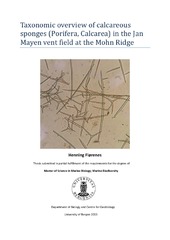Taxonomic overview of calcareous sponges (Porifera, Calcarea) in the Jan Mayen vent field at the Mohn Ridge
Master thesis
Permanent lenke
http://hdl.handle.net/1956/8025Utgivelsesdato
2013-12-17Metadata
Vis full innførselSamlinger
Sammendrag
The Porifera is a very old group of organisms that has been dated back to more than 500 million years. They are important to marine benthic communities by providing protection, contributing to nutrient recycling and working as spawning grounds. The exclusively marine Calcarea is a small class of sponges characterized by having a skeleton of calcium carbonate, which separates them from the other classes. The calcareous sponges are normally found in shallow waters, however they have been found all the way down to 4000 m and even at hydrothermal vents. The Jan Mayen hydrothermal vent field is located on the Arctic Mid-Ocean Ridge (AMOR) that was discovered in 2006. From 2006 to 2013 there have been several cruises to this vent field, and sponge samples were collected in 2006, 2011 and 2012. In other habitats calcareous sponges usually represent only a small part of the total sponge fauna, but at the Jan Mayen vent field the majority of the sponge fauna was calcareous. This thesis aims to give a description of the calcareous sponges from the Jan Mayen Vent Field using morphology and molecular data (28S rRNA sequences). Five calcareous sponge species were identified, of which four were previously known from Atlantic/Arctic waters; Brattegardia nanseni, Clathrina pellucida, Sycon cf. abyssale and Grantia cf. mirabilis. The fifth species, Grantia sp. nov., is new to science and the most abundant species in the area. The only potentially vent-endemic species is the new species of Grantia, and thus the calcareous sponge fauna conforms to the general pattern of low levels of endemicity at the Jan Mayen Vent Field. Because of the harsh environment at the hydrothermal vents, it is surprising to see such an amount of calcareous sponges present.
